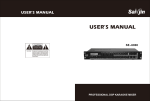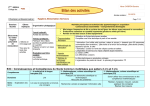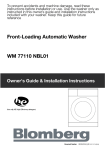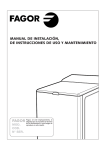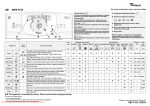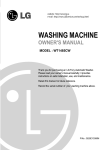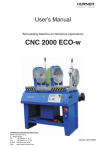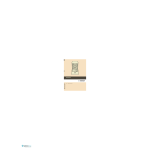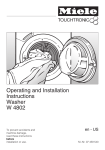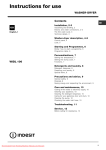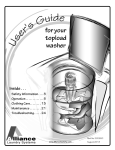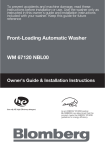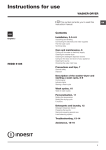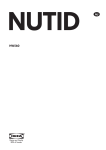Download Bosch WOT 20352 Manual User Guide Pdf
Transcript
Washing machine Instruction manual Read these instructions before operating the washing machine. Downloaded From WashingMachine-Manual.com Manuals en Contents Page Safety instructions...................................................................................................... Protection of the environment/Hints and tips........................................................ Disposal information .................................................................................................. Introducing your washing machine ........................................................................ 4 4 4 5 1 - Installation instructions Transportation protection devices .......................................................................... Moving the washing machine .................................................................................. Connections - Water supply- .................................................................................... Connections - Water drainage .................................................................................. Electrical connections................................................................................................ Replacement of mains cable .................................................................................... Installation.................................................................................................................... 6 and 7 7 8 8 9 9 9 2 - Operating instructions International laundry care symbols .......................................................................... 10 Before the first wash .................................................................................................. 10 Treating stubborn stains............................................................................................ 11 Preparing the laundry ................................................................................................ 12 Loading the laundry.................................................................................................... 13 Putting in detergent.................................................................................................... 13 Setting the programme.............................................................................................. 14 Choosing programme ................................................................................................ 15 Spin speed selector.................................................................................................... 16 Additional function buttons ...................................................................................... 17 Adding wash + Changing programme .................................................................... 18 and 19 Special applications .................................................................................................. 20 Safety features ............................................................................................................ 20 3 - Cleaning and care Cabinet ........................................................................................................................ Control panel, base, etc. interior components ...................................................... Detergent dispenser .................................................................................................. Cleaning the filter........................................................................................................ 21 21 21 22 4 - Display lights .............................................................................................................. 23 5 - What to do if .............................................................................................................. 25 6 - Customer Service .................................................................................................... 26 7 - Programme chart ...................................................................................................... 28 In addition, the following symbols indicate: Safety measures (for the machine or the laundry) that must be carried out without fail, Electrical danger, Suggestions and important information. Downloaded From WashingMachine-Manual.com Manuals 2 The new washing machine that you have just purchased is a modern, high-quality household appliance. Your washing machine is distinguished by its economical consumption of energy, water and detergent. Every washing machine that leaves our factory is carefully checked to ensure that it is functioning properly and is free of defects. If there are any questions - especially in regards to installing and connecting the washing machine - our Customer Service is at your disposal. For further information about products, accessories, spare parts and services visit our web site www.bosch-home.com or contact our after-sales service centres. Please read and follow these operating and installation instructions and all other information supplied. These operating and installation instructions describe various models. Differences are indicted in the appropriate places. Retain all documentation for subsequent use or for the next owner of the appliance. Downloaded From WashingMachine-Manual.com Manuals 3 Safety Instructions Intended use Exercise care when draining the hot water. Do not climb onto the washing machine. Follow the installation instructions. Your washing machine is intended • strictly for household use • for washing machine washable fabrics in water • for use with cold drinking water and standard commercial washing and cleaning products that are suitable for use in washing machines. Danger of suffocation! Keep children away from shipping carton and packaging components. Danger of suffocation from folding cartons and plastic film. Danger! On out-of-service appliances, unplug mains plug. Cut off power chord and discard with mains plug. Break the lock on the lid as this will prevent children from locking themselves in and suffocating. Safety Instructions Do not leave children unsupervised near the washing machine. Keep pets away from the washing machine. Do not insert/pull out the mains plug with wet hands. Do not pull out the mains plug by tugging on the cable. Protection of the environment/Hints and tips Your washing machine uses water, energy and detergent efficiently. This protects our environment and reduces your household costs. To use your washing machine in an efficient and environmentally friendly manner: • Do not exceed recommended loads. Cottons and Coloureds ....................5.5 kg Easy Care ............................................2.5 kg Delicates/Silk......................................1.0 kg Woollens..............................................1.5 kg Automatic load sensing reduces the water and energy consumption, as well as the programme duration, for smaller loads. • Instead of ”Cottons 90°C”, select the ”60°C” programme + the ”Intensive”* pushbutton. The extended washing time of this 60°C programme achieves a cleaning result comparable to that of the 90°C programme, but uses considerably less energy. • Do not use Prewash* for lightly to normally soiled washing. • Use detergent according to Pollution index, amount of laundry and water hardness and follow the manufacturer's directions. * Depending upon the model. Packaging and discarded appliances Environmentally friendly disposal • Dispose of packaging in an environmentally friendly manner. • This appliance meets European guideline 2002/96/EG for discarded electrical and electronic appliances (waste electrical and electronic equipment - WEEE). • The guideline provides an EU wide valid framework for recycling of discarded appliances. Downloaded From WashingMachine-Manual.com Manuals 4 Introducing your washing machine Control panel Lid handle (remains locked during the programme) Unlocking of detergent dispenser Removable detergent dispenser Button for opening the drum lids Locking lever (depending upon the model) Properly close drum lids! click! Water drainage hose Identification plate (appliance and production number) Securing bar for transport Water inlet hose (not connected) Mains connection with plug Downloaded From WashingMachine-Manual.com Manuals 5 YES NO Removing the transport securing devices Before the machine is used for the first time, all transport securing devices from the back of the appliance must be removed and stored for any later transport (i.e., relocation). 1 Remove the machine from the transport base. Remove wedge 훽 (Figure 1). Check to see that both plastic inserts on the connecting carrier have also been removed. Reinstall screws 훾 in their original positions. 2 Remove the 4 screws 훾 with a screwdriver (Figure 2.1). 3 Remove transport securing device 훿 Remove both screws (Figure 2.2) using a number 10 or 13 spanner (depending upon the model). 4 Figure 1 Both holes must be covered with the caps provided (found in the accessories package) (Figure 2.3)! Figure 2.1 Figure 2.2 13 Figure 2.3 2 2 A Downloaded From WashingMachine-Manual.com Manuals 6 1 1 Removing the transport securing devices 5 Remove the securing device (Figure 3). 6 To do this: - Remove securing device - With a quarter turn, remove securing device - Release the drum doors, locked in the lower position, by pressing down on both eaves simultaneously. Figure 3 Remove hose bracket ➀ and cover the holes with the caps provided ➁ (found in the accessories package) (Figure 4)! Figure 4 F b ➀ a G b a We recommend retaining all transport ➁ Before leaving the factory, the washing securing devices since these will have to be reinstalled for any later possible transport of the appliance. machine was carefully inspected. It is possible that some water from testing remains in the appliance or in the detergent compartments. Moving the appliance (depending upon the model) If the machine is fitted with hidden castors, it can easily be moved. To place the machine on the castors, turn the lever on the bottom to the left until it encounters a limit stop (Figure 5). During operation, the machine must always rest firmly on its feet (lever to the right). Figure 5 Downloaded From WashingMachine-Manual.com Manuals 7 Connections Cold water supply - Minimum water pressure: 0.1 MPa or 1 bar - Maximum water pressure: 1 MPa or 10 bar 3/4” Drain Figure 7.1 Mount drain hose with the supplied elbow, connect to a vented drain (Figure 7.1/7.2). The elbow must be between 65 and 90 cm above the floor. Secure drain hose against slipping off. Replacing the water-inlet hose After replacement, check to ensure connections are tight and that there are seals on both ends. Regularly check the condition of the water-inlet and drain hose Replace damaged hoses only with original replacement parts which are available through Customer Service. Figure 7.2 Downloaded From WashingMachine-Manual.com Manuals 8 min. 10 mm Figure 6 Connect water-inlet hose (Figure 6) Connections Electrical connections Changing the mains lead Connect the washing machine only to For reasons of safety, the mains lead is only to be replaced by Customer Service which is authorised to do so. alternating current via a properly installed earthed socket. The mains voltage must correspond to the voltage specification on the washing machine (identification plate). Connection specifications as well as the required fuses are stipulated on the appliance identification plate. Ensure that: • the mains plug and socket are compatible, • the cable cross-section is adequate, • the earthing system has been installed correctly. Do not use multiple plugs/sockets or extension cables. If a residual current circuit breaker is used, only use one that has this symbol: . Only this symbol can guarantee compliance with all applicable regulations. Do not insert/pull out the mains plug with wet hands. Do not pull out the mains plug by tugging the cable. Installation Safety Instructions Figure 8 Risk of Injury! The washing machine is very heavy. Take care when lifting it. Frozen hoses may tear or burst. Do not install the washing machine in an area where there is a risk of freezing or outdoors. Do not lift up on any protruding components. The washing machine may be damaged. In addition to the safety information listed here, the local water and electricity supplier may have special requirements. If in doubt, have the appliance connected by a specialist. Adjustable feet: (depending upon the model) Some appliances have two adjustable feet available at the front with can be used to correct for surface unevenness. Level and stabilise the machine in the following manner: - Tip the washing machine gently backwards. - Depending upon the type of floor, rotate the foot or feet in or out (Figure 8). - Check the washing machine for stability. Installation surface Stability is important so that the washing machine does not "wander" during spin cycles. Surfaces used for installation must be solid and even. Soft floor coverings are not recommended, i.e. carpets or floors with foam backing. Downloaded From WashingMachine-Manual.com Manuals 9 International Laundry Care Symbols In order to assist you in taking care of your textiles, these contain a label with the necessary information. The information is given by the following symbols : WASHING (Washtub) 95 95 60 Normal Gentle Normal washing washing washing prog. prog. prog. 60 40 40 30 40 Gentle Normal Gentle Special Gentle Hand washing washing washing Gentle washing washing washing prog. prog. prog. prog. prog. Do not wash The values in the washtub correspond to the maximum water temperatures that are not to be exceeded. A line below the washtub indicates gentle (mechanical) handling (for example, washing with slow rhythm). It denotes wash cycles that are suitable, for example, for Easy-Care and delicate articles. CHLORINE (Triangle) cl Do not use chlorine bleach Chlorine bleach may be used IRONING (Flatiron) hot iron medium iron cold iron no ironing The dots indicate the temperature ranges of the automatically controlled iron. CHEMICAL CLEANING (Cleaning drum) A P F P F no cleaning with chemicals DRYING in the washer-dryer Drying with reduced thermal loading Drying with normal thermal loading Drying in the washerdryer not possible The dots indicate the drying levels of the tumbler (laundry dryer). Before the first washing - wash once without laundry articles Before you wash laundry for the first time, we suggest running the ”COTTONS 90°C without Prewash“ wash cycle without laundry and with 1/2 measuring cup of detergent. In this way, any water left over from testing the machine will be removed. Downloaded From WashingMachine-Manual.com Manuals 10 © COFREET The letters are for dry cleaning. They provide information in regards to solvents. The line below the circle indicates that a reduction of mechanical action, moisture and temperature is required during cleaning. Treating stubborn stains Perspiration, blood, fruit, wine and chocolate stains are generally removed by using detergents with biologically active ingredients. Other stains however require special treatment before washing. First test on an inconspicuous area of the article and then rinse thoroughly. When applying stain remover, always start from the outside to avoid forming a border. MAKE-UP: Lay the side of the material with the stain on a piece of paper towel and moisten the other side of the article with 90 percent alcohol* insofar as the item permits and the stain is not greasy. Otherwise, use a grease solvent (e.g. trichloroethylene*). COFFEE - TEA: - On white cottons: dab the stain with hydrogen peroxide* and afterwards wash as usual. - On coloured cottons: dab the stain with a vinegar solution (2 tablespoons of clear vinegar in ¼ litre of water) and afterwards wash as usual. - On woollens: dab the stain with a mixture of equal parts of alcohol* and clear vinegar and afterwards wash the article. CHOCOLATE - FRUIT - FRUIT JUICE - WINE: Dab the stain with a vinegar solution (2 tablespoons of clear vinegar in ¼ litre of water). Rinse thoroughly and wash as usual. GREASE: Immediately sprinkle talcum powder on the material. Let dry and gently brush off the talcum powder. Then dab with a grease solvent, such as gasoline*. Rinse out and wash as usual BLOOD: Immerse the stained item in cold salt water as quickly as possible; afterwards wash as usual. KETCHUP - TOMATO SAUCE: Prepare a solution of 50% glycerine and 50% warm water. Soak the item for an hour and afterwards wash as usual. GRASS: Dab the stain with clear vinegar or 90 percent alcohol* (if the material permits), rinse out and wash. BALLPOINT PEN - FELT TIP: Dab the stain with paper towels to absorb as much ink as possible. Put a white, clean cloth under the stain and then dab it with another cloth. For synthetics, the second cloth should be moistened with clear vinegar; for other fibres with 90 percent alcohol* (in so far as the material allows). RUST: Sprinkle light stains with salt. Sprinkle the salt with lemon juice and let work overnight. Next day, rinse thoroughly and wash. For larger stains, use a special rust remover, paying especial attention to the manufacturer's instructions. CHEWING GUM: Cool down with an ice cube. As soon as it is hard enough, remove using your fingernails. Remove the border that remains using a grease remover*. AUTOMOBILE GREASE - TAR: Use spot remover*. If none is available, smear the stain with some fresh butter, let work and then dab with oil of turpentine*. PAINT: Do not allow paint stains to dry; immediately treat with the solvent indicated on the paint can (water, turpentine*, light petrol*). Soap and rinse out. CANDLE WAX: Scrape off most of the stain. Then put paper towels on both sides of the item and melt the remaining wax using an iron. USING STAIN REMOVERS: To avoid the risk of a fire or explosion: (*) When using the solutions mentioned above, rinse the articles thoroughly before putting them into the washing machine. - Strictly follow the manufacturer's instructions when using common stain removers. After stained fabrics have been washed and then dried in the dryer or ironed, the stains can no longer be removed. Downloaded From WashingMachine-Manual.com Manuals 11 Preparing the laundry To prepare the laundry • In a net/cushion cover, wash: - Delicate items e.g. tights, curtains, - Small laundry items, e.g. socks or handkerchiefs - Underwired bras (underwires may become detached during washing and cause damage). ) • Trousers, knitwear and knitted textiles, e.g. jersey garments, T-shirts or sweatshirts, should be turned inside out. Foreign objects (e.g. coins, paperclips, needles, nails) may damage laundry items or washing machine components (the drum for example). • Empty the pockets of the laundry items. • Brush sand out of pockets and cuffs/turn-ups. • Close zippers, button covers. • Remove curtain rollers or tie up in a net/bag. Do not exceed the following load limits: COTTONS / COLOUREDS / MIXED: ................................................................................ 5.5 kg EASY-CARE: ........................................................................................................................ 2.5 kg WOOLLENS: ..........................................................................................................................1.5 kg DELICATES / SILK: ..................................................................................................................1 kg Average weight of several dry, ”light“ laundry items Bed linen for 1 person . . . . . . . . . .400 to 500 g Bed linen for 2 persons . . . . . . . . . . . . . . .800 g Pillow cover . . . . . . . . . . . . . . . . . . . . . . . . .200 g Light night-gown . . . . . . . . . . . . . . . . . . . . .150 g Children's cloth pants . . . . . . . . . . . . . . . .120 g Cloth trousers . . . . . . . . . . . . . . . . . . . . . . .500 g Man's shirt cotton/polyester . . . . . . . . . . . 200 g Cotton T-shirt, large . . . . . . . . . . . . . . . . . .150 g Tea towel . . . . . . . . . . . . . . . . . . . . . . . . . . .100 g Table cloth . . . . . . . . . . . . . . . . . . . . . . . . .250 g Delicate lady's items . . . . . . . . . . . . . . . . . . . .50 g Children's knitted synthetics . . . . . . . . . . . .50 g Socks . . . . . . . . . . . . . . . . . . . . . . . . . . . . . . . 20 g Cloth pyjamas . . . . . . . . . . . . . . . . . . . . . . .250 g Average weight of several dry, ”heavy“ laundry items Jeans . . . . . . . . . . . . . . . . . . . . . . . . 800 g to 1 kg Terry cloth bath towel . . . . . . . . . . . . . . . . .700 g Terry cloth hand towel . . . . . . . . . . . . . . . .300 g Jogging pants . . . . . . . . . . . . . . . . . . . . . . .350 g Children's terry cloth pyjamas . . . . . . . . . .100 g Bathrobe . . . . . . . . . . . . . . . . . . . . . . . . . .1,200 g Sweatshirt . . . . . . . . . . . . . . . . . . . . . . . . . . .250 g Plumeau case . . . . . . . . . . . . . . . . . . . . . .1,500 g Downloaded From WashingMachine-Manual.com Manuals 12 Loading the wash Danger of explosion! • Unfold pre-sorted laundry items and loosely load into the washing drum. Mix large and small items. Laundry items of different sizes distribute themselves better during the spin cycle. Do not exceed suggested loads (see also PROGRAMME CHART). Overfilling reduces washing efficiency and promotes creasing. Water and energy consumption by the washing machine is automatically reduced for smaller loads. • Close drum lid. Do not wedge laundry items between the drum and the drum lid. Ensure that the drum lid is properly closed. If laundry treated with cleaning agents containing solvents, e.g. stain removers or benzene, is loaded into the washing machine, an explosion may result. Thoroughly rinse out laundry items in advance by hand. Foreign objects in the washing drum may damage laundry. Check the drum for foreign objects before putting in the laundry. Opening the washing machine • Lift handle to open. • Press button to open the drum lid. Putting in detergent ➀ ➁ ➀ ➁ ➂ ➃ ➂ ➃ Prewash compartment (powder) Main wash compartment (powder or liquid) Fabric softener cl Function not available : WASHING POWDER : LIQUID DETERGENT Figure 9 Loading detergent The main wash compartment can hold Use the amount of detergent appropriate for - The hardness of the water. The hardness of the water can be found from the water utility company. - The size of the load. - The degree of soiling. - The specifications of the detergent manufacturer. Put liquid detergent in the appropriate dispenser. powder as well as liquid. However, do not use liquid detergent for the program WITH Prewash and/or WITH ”Delayed Start“ (depending upon the model). Concentrated fabric softener must be diluted with warm water! Do not exceed the level indicated by MAX. Do not put detergent directly into the drum. Risk of poisoning! Keep detergents and additives out of the reach of children. Downloaded From WashingMachine-Manual.com Manuals 13 Setting the programme Programme selector Display panel for programme length and Delayed Start 1 Starting time button A 2 3 4 Spin speed selector Additional function buttons 5 Start/Pause button Selecting the programme: Display panel and the position of the spin speed selector •Select the desired programme 1 using the programme selector. In A Programme length, e.g. • Set the desired spin speed 2 using the spin speed selector (see chart, page 16). Set spin speed selector 2 to desired position (e.g. ”800“). • If applicable, select options 4 using the additional function buttons. The indicator light for the selected option lights up. • Start the programme using 5 the ”Inicio” (Start) button. Remaining time indicator A ...or a Delayed Start 3 of 1 to 19 hours can be selected using the button. Time remaining until start of the programme in A • At the end of the cycle, the display panel indicates A ”- 0 -“. Turn programme selector 1 to ”0“. Open lid and remove laundry. Downloaded From WashingMachine-Manual.com Manuals 14 Selecting the programme Basic programme Sport Select the desired programme - also see the Programme Chart. For the maximum spin speed of the programme, see the chart on the next page. 40°C For dark-coloured fabrics made of cotton and dark easy-care fabrics. Reduced rinse and final spin cycle. Woollens (Lana) U frio (cold), 30, 40°C Cottons+Linens (Pesados/Algodón) y 60°C For hand- and machine-washable wool or wool-rich textiles, e.g. cashmere, mohair or angora. Energy intensive programme for heatresistant textiles, e.g. made of cotton or linen. To protect the wastewater pipes, the hot wash water is mixed with cold water and cooled before being drained. Silk (Seda) frio (cold) For hand- and machine-washable silk textiles. Quick Wash 40°/30 min (Rapido 30 min.) Cottons+Linens (Pesados/Algodón) y 60°C + ”Intensivo” button I For stained, heavily soiled textiles, e.g. cotton or linen. Energy saving programme. The extended washing time achieves a cleaning result comparable to that of the 90°C programme, but uses considerably less energy. For a load of lightly soiled laundry items up to 2.5 kg. To freshen up cottons, linens, coloureds or hard-wearing synthetics. Washing temperature automatically set to 40°C. Time limited to 30 minutes. For this programme, reduce the amount of detergent by half! Cottons+Linens (Pesados/Algodón) y 60°C + Prelavado (Prewash) Additional programme selections For heavily soiled, hard-wearing textiles. Rinse (Flot) K Cottons+Linens (Pesados/Algodón) y frio (cold), 40, 60°C Separate rinse cycle with subsequent spin for Easy-Care textiles. For hard-wearing textiles. Spin (Centrifugado) B Easy-Care (Sintéticos) A frio (cold), 40, 60°C Separate spin cycle. Wash or rinse water is pumped out before the spin cycle. For Easy-Care textiles, e.g. made of cotton, linen, synthetic or blended fabrics. When choosing ”rinsing“ and ”spinning“ programmes, note the appropriate spin speed, see chart on page 16. Delicates (Delicado) q frio (cold) For delicate, washable textiles, e.g. made of cotton, synthetic or blended fabrics (e.g. curtains). Downloaded From WashingMachine-Manual.com Manuals 15 Spin speed Spin speed (depending upon model) with spin speed selector* Programme 1200 1100 1000 900 800 COTTONS + LINENS / COLOUREDS 1200 1100 1000 900 800 COLOUREDS with Prewash 1200 1100 1000 900 800 EASY-CARE* 1000 1100 1000 900 800 WOOLLENS / SILK* 800 800 800 800 800 DELICATES* 600 600 600 600 600 SPORT* 600 600 600 600 600 HAND WASHABLE TEXTILES* 600 600 600 600 600 I Q QUICK WASH 40°C / 30 min 1000 1000 1000 900 800 100 GENTLE SPIN** 100 100 100 100 100 L RINSE STOP*** — — — — — y y A U q * In the ”Easy-Care“, ”Delicates“, ”Sport“ and ”Woollens/Silk“ programmes, the spin speed is limited automatically. ** Gentle Spin: Gentle reduced spin cycle at 100 rpm. *** Rinse Stop: Laundry remains in the last rinse water. PROGRAMME FOR STANDARD AND COMPARISON TESTS Programme ......................................................................................................COTTONS 60°C Load .................................................................................................................................. 5,5 kg Duration ..........................................................................................................................140 min Programme setting for testing in accordance with or following EN 60 456 and IEC 60 456. Downloaded From WashingMachine-Manual.com Manuals 16 Auxiliary function pushbuttons RINSE STOP L PREWASH (Prelavado) P (depending upon model) For heavily soiled, hard-wearing textiles, e.g. from cotton or linen. The Prewash washing temperature is 30°C. Prewash not available for Woollens or Delicates programme. If the Prewash programme is aborted, the washing water is drained and the programme continues with the main washing cycle. For delicate textiles and curtains. The laundry remains in the final rinse water. The laundry goes through a short intermediate spin cycle; also for ”Delicates“, ”Woollens/Silk”. In this way, better rinsing takes place. For RINSE STOP, both symbols A alternate on the panel display: and . Detergent must be put into detergent - The machine should be emptied and the laundry spun. compartment ”I“. Using the spin selector 2 choose one of the spin speeds appropriate for the type of laundry. The programme ends automatically. The remaining time is indicated on the display panel. RINSE PLUS (Aqua extra) K (depending upon model) Especially for sensitive skin and for areas with very soft water. Adds an additional rinse cycle. - Machine is only to be drained. EASY-IRON (Fácil e) f Using the spin speed selector 2 select the ”Gentle Spin” function. The laundry is gently spun dry. The remaining time is indicated on the display panel. (depending upon model) This option washes your laundry more gently, but with an identical washing performance. The spin speed is slower so that your laundry creases less. INTENSIVE (Intensivo) X (depending upon model) For heavily soiled laundry, the washing times are increased for the Cottons, Coloureds and Easy-Care programmes. By selecting 30--60°C, the wash temperature is increased 4°C. Downloaded From WashingMachine-Manual.com Manuals 17 Delayed Start By pressing the pushbutton 3 multiple times, the start of the programme can be delayed from 1 to 19 hours. The selection is confirmed after a few seconds. To activate the delayed starting, press the ”Inicio” (Start) button. The course of the Delayed Start is displayed A every hour from 19 hours to 1 hour, and then every minute from 59 minutes to 1 minute. During the entire process, the Delayed Start symbol is illuminated. The four segments flash in succession. After the Delayed Start time ends, the programme starts and the remaining time is indicated on the display panel A . During the course of the Delayed Start, the settings may be changed at any time, see section ”Changing the programme“. Topping up laundry + changing programs Adding or removing laundry (not possible during spin cycle): During the washing cycle, laundry may be added or removed. • Press the ”Inicio” (Start) button 5 to abort the programme. • Remove or add laundry if necessary. (*) It may be 1 to 2 minutes until the lid unlocks. • Press the ”Inicio” (Start) button 5 to restart the programme. If a Delayed Start has been selected, the drum may be opened at any time before the start of the programme without aborting the programme and having to start anew. In A the indicated remaining time is stopped. In A the remaining time function is again activated (two dots flash). Changing the programme Terminating the programme If you have chosen the wrong programme: • Turn programme selector to ”0“. • Set programme selector to the desired programme. • Press ”Inicio” (Start) if applicable. The spin speed may be changed at any time during the programme. As long as they have not finished, all options may be activated or deactivated at any time during the course of the programme. If you would like to terminate a programme before it is completed: • Turn programme selector to ”0“. • Set programme selector to ”Centrifugado” (Spin). Select desired spin speed for ”Spin“ (but not Rinse Stop). • Press ”Inicio” (Start) button. Downloaded From WashingMachine-Manual.com Manuals 18 Changing the programme (continued) Changing the programme: - during the preselection of starting time: All modifications are possible before the ”Inicio” (Start) button 5 has been pressed. During the preselection of the starting time, all programme changes are allowed. The preselection of starting time may be changed at any time, e.g. up to 18 hours by using pushbutton 3 . If the programme should start immediately, set the starting time back (a step after 19 h) and press the ”Inicio” (Start) button. All available additional functions may be activated during the preselection of starting time. - immediately after the start of the programme: Change programme (e.g. from ”COTTONS“ to ”DELICATES“ etc.). Then press ”Inicio” (Start) button 5 again. - during the washing programme: Change programme (e.g. from ”DELICATES“ to ”COTTONS“ etc.). Then press ”Inicio” (Start) button 5 again. Some of the water may be drained. The entire programme begins anew. The temperature can be changed during the programme without pressing the ”Inicio” (Start) button again. The spin speed may be changed at any time. All additional functions may be activated or deactivated during the entire programme as long as they have not finished. - at the end of the programme: If appears in the display A , a new programme may be selected without first having to set the programme selector 1 on ”0“. Before switching on the machine,check that the mains lead is connected and the tap is open. Ensure that all lids are properly closed. For purposes of safety, it is suggested that the mains cable be unplugged and the tap closed when the programme has ended. After a power outage, the programme resumes from the point at which it was broken off. Downloaded From WashingMachine-Manual.com Manuals 19 Special applications Soaking Starching •Insert washing of the same colour. •Pour soaking agent into dispenser II according to the manufacturer’s instructions. •Select the ”Pesados/Algodón frio” programme. •Press the ”Inicio” (Start) button. The programme starts. •After approx. 10 minutes press the ”Inicio” (Start) button. The washing is now in the water. •After the required soaking time select and start a programme. No additional detergent required, the soaking solution is used for washing. The washing should not be treated with fabric softener. •Insert the washing. •Dose a quantity of starch for approx. 15 litres of water. Dissolve starch according to the manufacturer’s instructions. •Select the ”Flot” programme. •Set the spin speed. •Pour starch solution into dispenser . •Press the ”Inicio” (Start) button. Dyeing / Bleaching Do not dye too frequently. The salt can have an aggressive action on stainless steel! Respect the indications of the manufacturer of the dye! Never bleach washing in the washing machine. Safety features Lid opening safeguards: Spin safeguards: After the programme starts, the appliance lid is locked. After the programme ends or during ”Rinse Stop”, the lid is unlocked. Depending upon the model: Depending upon the model, if a ”Delayed Start” was programmed, the lid remains unlocked during the entire waiting period before the start of the programme. If the lid is to be opened during the programme, quickly push the ”Start” - button and wait approximately 1 to 2 minutes until the lid safety unlocks. In order to avoid scalding, the lid remains locked until the wash water has cooled down somewhat. The washing machine is equipped with a safety feature that can reduce the spin speed if imbalanced loading occurs. In this case, the laundry may be insufficiently spun dry. Evenly distribute the laundry in the drum and programme a new spin cycle. Safeguards against excess foaming: Too much foam may be produced in your washing machine during spinning. In this case, the spinning is stopped and the machine is drained. The programme continues. The spin speed is adjusted and an additional rinse cycle is performed. Water safeguards: During operation, the constant water level control prevents possible overflows. Downloaded From WashingMachine-Manual.com Manuals 20 Cleaning and Care Risk of electrical shock! Detergent compartment Clean the detergent dispenser regularly. For this purpose: - To remove the detergent dispenser, squeeze both pressure points simultaneously (Figure 10). The dispenser then detaches itself from the compartment (Figure 10). - Remove parts at the rear of dispenser and separate from front cover (Figure 11). - Rinse the parts under running water. Completely empty the dispenser. - Reassemble all components in the proper order. Snap the detergent compartment into place under the lid of the washing machine. Completely disconnect the washing machine from the mains. Never clean the washing machine with a jet of water. Explosion hazard! Never use solvents for cleaning. Danger of freezing! When there is danger of freezing, remove the water inlet hose and completely drain the washing machine. In this way, excess water that could still be in the dispenser will be drained out. Cabinet Use only soap and water. Figure 10 Control panel, base, etc. Use only a moist towel. Do not use: • Scouring powder • Metal pads or plastic sponges • Alcohol-based products (alcohol, diluents, etc.) Interior components It is recommended: • to leave the lid open for some time after washing. • to clean the plastic and rubber parts of the washtub inlet about once a month with soapy water. Rinse thoroughly to remove all traces of this cleaning material. • it is suggested that the 90°C washing programme be run at regular intervals. Figure 11 H Filters in the water inlet We recommend that you regularly clean the filters in the water inlet. I Downloaded From WashingMachine-Manual.com Manuals 21 J Cleaning the Filter If the pump filter is not regularly • Gently turn the drum with the open lids to front side of the machine (Figure 14). cleaned, then this may adversely affect the performance of the machine. Figure 14 Cleaning the pump filter This filter collects bits of fluff and small objects, e.g. detached buttons that have fallen into the container. To clean, proceed as follows: • Open the drum lids. On the floor of the drum, there is a laundry agitator 훽 (Figure 12). B Figure 12 • Remove pump filter 훾 from its holder (Figure 14). • Remove foreign objects and fluff. • Clean filter under running water (Figure 15). A Figure 15 Unfasten this part (Figure 13). For this purpose: Figure 13 ➁ ➀ • Press filter back into its holder up to the stop. • Reinstall laundry agitator 훽. Slide the laundry agitator to the left until part 훽 engages audibly (Figure 16). • Insert a dowel (for example, a pencil or a screwdriver) in the hole in part 훽. • Press this dowel downwards and simultaneously slide part 훽 towards the right until it releases. • Remove part 훽. Figure 16 ! CLliAcNkG C ➁ ➀ Downloaded From WashingMachine-Manual.com Manuals 22 Troubleshooting minor faults Malfunctions of the washing machine are indicated on the display panel. Flashing indicator Cause / Remedial action No water flows in. Open tap and press the ”Inicio“ button again. This malfunction may be caused by an improper water supply hose connection (see chapter ”CONNECTIONS: Water-inlet hose“). Pump filter blocked. Clean the pump filter (see chapter ”CLEANING THE FILTER“) and restart the program with the ”Inicio“ button. Check drain hose: The connection must not be blocked (see chapter ”CONNECTIONS: Water drainage“). Drain hose condition: The connection must not be blocked (see chapter ”CONNECTIONS: Water drainage“). Drum blocked. Check if a small laundry item (e.g. handkerchief, sock...) has got between the detergent dispenser and drum. For access to the bottom of the dispenser, refer to the chapter ”CLEANING THE FILTER“ Lid improperly closed. Check if the lid is closed. Start the programme using the ”Inicio“ button. Downloaded From WashingMachine-Manual.com Manuals 23 Faults that require repair service Please check if the display indicates a malfunction that you may fix by yourself (see above)! The following indicators require repair service: Flashing indicator etc. If these indicators appear: - Turn programme selector to ”0“. - Pull out mains plug for 10 s. - Reinsert mains plug. - Select programme and start again. If the indicated malfunction remains, the service department is to be notified. SUGGESTION: Disconnect washing machine from mains and turn off tap. Downloaded From WashingMachine-Manual.com Manuals 24 What to do if... If a malfunction can not be remedied with the assistance of the following chart: •Turn programme selector to ”0”. • Disconnect washing machine from mains. • Turn off tap. Risk of electrical shock! Have repairs carried out only through Customer Service or by authorised specialists. Problem Possible cause / Remedial action Filters in the water inlet are blocked • Clean the filters. Severe vibrations during the spin cycle • The transport securing devices for the appliance have not been completely removed: - Check if all the transport securing devices have been removed. (see chapter entitled REMOVING THE TRANSPORT SECURING DEVICES) • The floor is not level. • The washing machine rests on both ”front” castors. - Push the locking lever towards the right. The laundry was not or was insufficiently spun dry • You have chosen a programme without a spin cycle, i.e. ”Gentle Spin”. • The imbalance control system has detected an improper distribution of laundry in the drum: - Resort the laundry and again select ”Spin”. Water issues from/under the machine • The drain hose is improperly inserted into the drainage line. • The water inlet hose leaks at the machine and at the tap: - Check the gaskets and connections. The machine does not drain out • ”Rinse Stop” was chosen. • The drain hose is broken or crimped. • Place drain hose on the floor and collect water in an appropriate glass. It is absolutely necessary to replace the hose bracket if the appliance is an Aquastop model ! • The drain pump filter is blocked: - clean the filter (see chapter entitled CLEANING THE FILTER) The programme does not start • The selection of the programme was not fully completed: - The ”Inicio” pushbutton has not been pressed. - Programme selector remains in the Stop position. • The washing machine is not supplied with power: - Check if the appliance plug is connected. - Check protection devices. • The tap is closed. • The inlet hose is torn • The lid is not properly closed. The lid does not open • The programme has not yet ended. The lid remains locked during the entire time of the programme. The drum lids open too slowly • The washing machine has not been used for a long time. • The washing machine is in a room that is too cold. • Residual detergent (powder) is blocking the hinges. - Remove residual detergent. Downloaded From WashingMachine-Manual.com Manuals 25 What to do if... Problem Possible cause / Remedial action The programme duration is shortened or lengthened while the programme is in progress. This is not a fault. The duration shown at the start of the programme is updated according to the amount of laundry loaded. This ensures a good washing result and optimum water and energy consumption. The safety system for the spin cycle and the foam protection function may lengthen the duration that is initially displayed. Customer Service Every washing machine that leaves our factory is carefully checked to ensure that it is functioning properly and is free of defects. If there are any questions - especially in regards to installing and connecting the washing machine - our Customer Service is at your disposal. If you cannot rectify the fault yourself (Troubleshooting –> page 25, 26), please contact our after-sales service. We will always find a suitable solution and will avoid a visit from a service technician wherever possible.You can find the contact details for your nearest after-sales service here or in the after-sales service directory (depending on model).. When calling Customer Service, please specify the product number (E-No.) and production number (FD-No.) of your appliance. This information can be found on the identification plate. By specifying the product number and production number of your appliance, you help us in our attempts to prevent unnecessary travelling. You save the associated extra costs. Further information and a selection of our products may be found on our Internet site: http://www.bosch-home.com - GB 0844 8928979 Calls from a BT landline will be charged at up to 3 pence per minute. A call set-up fee of up to 6 pence may apply. - IE 01450 2655 Rely on the professionalism of the manufacturer. Please contact us. This will ensure that the repair is carried out by trained service technicians who arrive equipped with genuine spare parts for your appliance. E-Nr FD The product number (E-No.) may be found behind the detergent dispenser. Directions for removal may be found in the chapter entitled CLEANING AND CARE. Downloaded From WashingMachine-Manual.com Manuals 26 Downloaded From WashingMachine-Manual.com Manuals 27 Robert Bosch Hausgeräte GmbH 1109 en Carl-Wery-Straße 34 TW2G00023-01 81739 MÜNCHEN 9000463454 DEUTSCHLAND Downloaded From WashingMachine-Manual.com Manuals SPIN DRY only RINSE only 2,5 1,0 1,0 1,5 ● ● O ● ● ● ● ● ● ● O O O Programme length (**) 1:56 - 2 :13 hrs 2:37 hrs 1:20 - 1:41 hrs 33 min 32 - 41 min 43 min 32 min ● ● ● ● ● ● ● ● ● ● ● ● ● ● Options for additional functions O Only one option possible in this programme 9 - 10 min 8 - 18 min 30 min ● O ● X Intensive* ● ● O K Rinse Plus* ● Q e Easy Iron* ● 100 Gentle Spin* minutes), the programme duration is determined based on the selected temperature and load (automatic load sensing). - If a programme with ”Intensive“ is selected, the programme is extended from 5 - 17 minutes. - If a programme with ”Rinse Plus“ is selected, the programme is extended from 9 - 20 minutes. (**) The programme length was given as an average value “Without Options”. IDuring the start phase (approx. 10 40° Frio HANDWASHABLE TEXTILES QUICK WASH 40°C/ 30 min Additional programmes 40° SPORT* Frio - 40° 1,0 Frio DELICATES WOOLLENS / SILK Special programmes 2,5 5,5 5,5 Frio - 60° 60° Frio - 60° Temperature (°C) * Frio = Cold EASY-CARE COLOUREDS with PREWASH* COTTONS + LINENS / COLOUREDS *Functions or options depending upon model K B I y y A q U Laundry type Programme Chart L Gentle Spin* To select the most suitable programme, follow directions on the labels that are found in most pieces of laundry. Maximum load (kg) Depending upon textile type ROBERT BOSCH HAUSGERÄTE GMBH




























